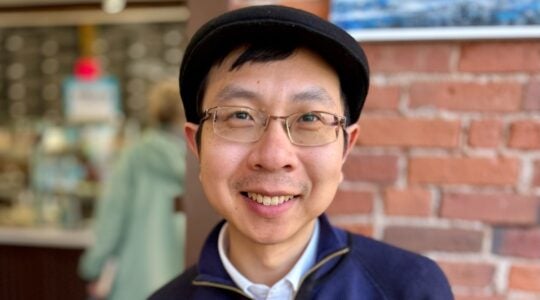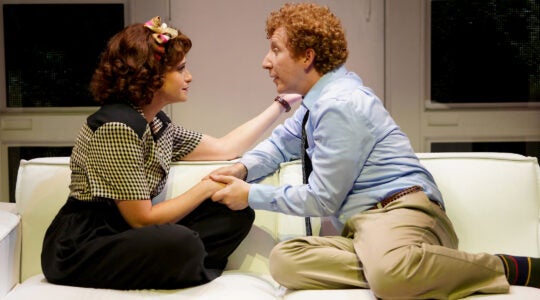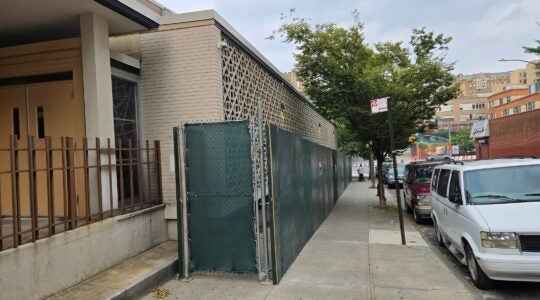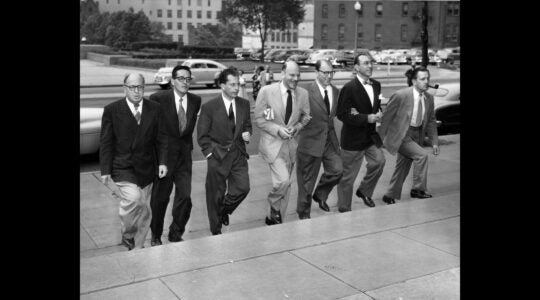Judging by their covers, Rabbi Michael Strassfeld’s just published work A Book of Life: Embracing Judaism as a Spiritual Practice (Schocken) and his earlier “The Jewish Catalog” (Jewish Publication Society) — published almost 30 years ago — couldn’t be more different. His new book is hardcover; its jacket features a traditional papercut design in deep colors, highlighted in gold, altogether very handsome. The first book, a paperback he edited along with Richard Siegel and Sharon Strassfeld, is bright red, with a do-it-yourself look.
Although dissimilar in format, the books share some similarities, as Rabbi Strassfeld points out in an interview with The Jewish Week in his study at the Society for the Advancement of Judaism, the Upper West synagogue he serves. Each book reflects its time: “The Jewish Catalog,” which sold more than 500,000 copies in its three volumes, was born of the Jewish counter-cultural movement in the 1960s and early 1970s, modeled after the successful “Whole Earth Catalog.” Rabbi Strassfeld and his colleagues explained how to be Jewish to a generation re-exploring its roots; the Judaism they presented was joyous, non-judgmental and participatory, with information on making Shabbat candles and how to say the appropriate blessings, about crafting mezuzot and the meaning of the text inside.
“A Book of Life” is published at a moment when many Jews are “looking for something that gives meaning to their lives, something larger than themselves,” Rabbi Strassfeld said. Gone are the directions for making handcrafted Judaica and braiding challah, and much expanded are the explanations of meaning, with new rituals; the book emphasizes living with an awareness of God’s presence, mindful of the words from Psalm 16, “I have placed God before me always.” Rabbi Strassfeld presents Judaism as a practice to engage on a regular basis, showing how daily life is infused with sparks of holiness, moments of caring, compassion and ethics.
Initially, Rabbi Strassfeld, now 50, set out to write a new “Jewish Catalog,” but realized that the times, and his own experience, called for a different kind of book. He begins with the idea of awakening to the day, covering, among other things, morning rituals, speech, work, close of the day and Shabbat. In a second section, he describes the paths of Torah; avodah, or work; and gemilut chesed, loving-kindness, and then goes on to describe the cycle of holidays through the year. In the final sections, he writes of the lifecycle, considering all sorts of passages, and concludes with reflections on Israel, ecology and God. Throughout the book are shaded sections with meditations, teachings and stories to aid in focusing.
Rabbi Strassfeld is a gentle and wise guide, well versed in the biblical, Talmudic, midrashic, chassidic and mystical texts he cites. “I’m trying to bring the depth and richness of Jewish tradition” to spiritual subjects, he says, showing how elements of contemporary spiritual practice, like meditation and paying attention, are rooted in Jewish sources.
His view veers from the traditional sense of halacha, which he says “too often seems too far away from the Presence of God.” He doesn’t suggest that Jewish rituals be practiced only when people feel moved, but rather on an ongoing basis, “coming from a place of wanting to do [them]rather than feeling obligated.” He writes, “The point of Judaism is not to pray three times a day or to observe the Sabbath or the holidays. Rituals should not be observed because we are ‘supposed to’ observe them, but rather because they help us achieve the real goal: awareness. To be a good Jew is not to do all the particular Jewish things perfectly. It is to live a life of goodness and holiness inspired by the teaching and structured by the traditions of Judaism.”
Another difference with the earlier book is that the author is now a rabbi. At age 39, he began rabbinical school and graduated from the Reconstructionist Rabbinical College in 1991. His religious biography shifts along the Jewish spectrum, although he has always been closely connected to Judaism. The son of an Orthodox rabbi, he attended Orthodox day schools and when his father became the rabbi of a Conservative synagogue, he refused to attend. He began his college studies at Yeshiva University but soon felt that he was no longer Orthodox in outlook and transferred to Brandeis. He joined Havurat Shalom, a Massachusetts religious community that was egalitarian, liberal, contemporary and traditional. “It was in the havurah that my Jewish life for the next 25 years was shaped,” he writes.
He explains that it took him a long time to decide to become a rabbi, partly because the havurah movement stressed lay participation over rabbinic leadership. But after doing a lot of Jewish programming, he felt that he had things he wanted to teach, so he began his rabbinic studies. Now, as a rabbi — he’s in his second year at SAJ, after serving at Ansche Chesed — he tries to balance religious and spiritual leadership with lay participation. He speaks of being part of a broad shift among rabbis, from the “old model of big man on pulpit” to a situation where the gap between rabbi and congregation is smaller.
Rabbi Strassfeld is soft-spoken and also dynamic, an unusual mix. The walls of his study are filled with framed Yiddish signs he has salvaged from synagogues shutting down. As he collects these pieces of Jewish Americana folk art, and also collects recordings of chasidic music (he has over 300). Another hobby is making papercuts, and his handiwork, based on traditional designs, illustrates the book jacket and interior. The process requires much patience, and he acknowledges that for many people working on such a small scale would be nightmarish. He finds that the work helps focus his attention. At meetings, he’s known to have his papercuts in front of him, working with his hands as he listens.
In leading Shabbat services and also at the weekly early morning meditation he leads at the JCC, Rabbi Strassfeld makes use of niggunim, wordless melodies that are repeated. He explains that these melodies, very much a part of his spiritual practice, are a way of moving beyond language, expressing things impossible to express with words; the soulful singing reaches deep inside and stretches toward heaven. He is just releasing his first CD, “Songs to Open the Heart,” a collection of these niggunim, composed in various chasidic communities.
Throughout the book, Rabbi Strassfeld shares stories of his own journey. In the section on lifecycle, he maps out the books of the Bible, overlaying the lifecycle of the people of Israel onto the contemporary lifecycle. For example, drawing parallels between the beginnings in Genesis and the birth process and ritual, he describes Bamidbar (Numbers), which covers the close to forty years of wandering in the desert, the time between the Revelation at Sinai and the arrival at the Promised Land, as the years between youth and old age. That’s the stage of life where he finds himself, past the milestone moments, with beginning signs of aging. He writes in general about issues of illness, visiting the sick, living wills, divorce, disappointments and blessings of the period, and tells of his own divorce and thoughts about turning fifty. For him, this is a time of self-knowledge and satisfaction, of feeling part of a community. “Psychologically, there are no empty spaces on my walls calling out to be filled,” he writes, agreeing with author Sharon Salzberg that, to paraphrase, happiness comes from having a loving, open heart.
Rabbi Strassfeld is also the author of “A Night of Questions: A Passover Haggadah,” co-edited with his wife Rabbi Joy Levitt, and “The Jewish Holidays: A Guide and Commentary.” Like those books, “A Book of Life” can be a good introductory text, but there’s also much in it for those already involved in Jewish life, who might find new inroads toward holiness, new ways to turn rote routines meaningful again.
Copies of Rabbi Strassfeld’s new CD, “Songs to Open the Heart,” are available from the SAJ office, 15 W. 86th St., New York, N.Y., 10024, (212) 724-7000. An exhibition of his handmade papercuts, based on traditional designs, is open to the public in the social hall at SAJ.
The New York Jewish Week brings you the stories behind the headlines, keeping you connected to Jewish life in New York. Help sustain the reporting you trust by donating today.




